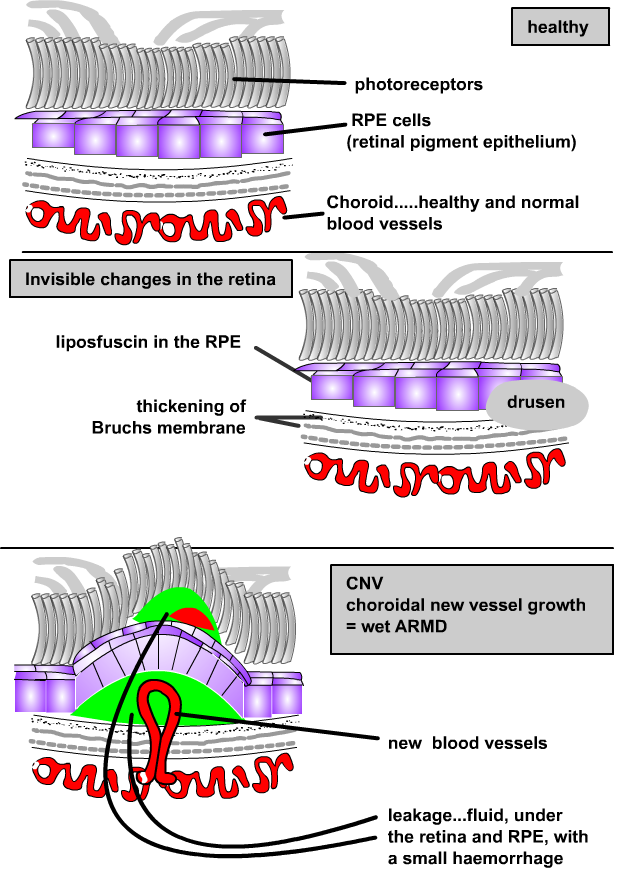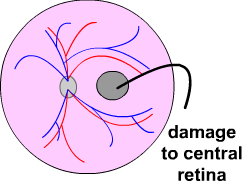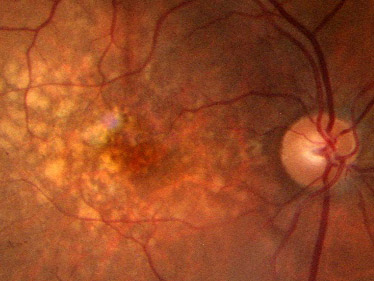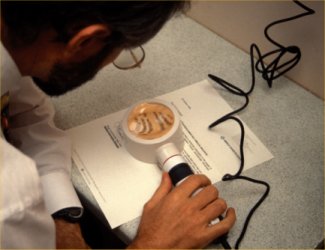Wet age related macular degeneration (ARMD): Lucentis and Avastin D Kinshuck |
Note:
|
|
Â
| What is ARMD (age related macular degeneration) Â |
The retina lines the back of the eye, like the film in a camera. The macula is the area in the centre of the retina. The macula is the part of the retina is responsible for detailed vision, that is seeing faces, reading, watching TV. If the macula is damaged central vision starts to become patchy or distorted. ARMD is one of the commonest types of macular damage, and is common in older people. AR MD does not cause blindness, but with reduced central vision life is more difficult |
|
.There are two types of ARMD, dry and wet.
|
Â
|
| Wet ARMD |
Wet ARMD is a condition in which blood vessels grow under the retina. They grow under the central retina, in the area is called the macula. These growing blood vessels then start to leak and cause a type of blister, like a small 'hill'. When wet ARMD develops central vision starts to become patchy or distorted or bent, after months central vision may get much worse. Before the wet ARMD develops, invisible aging changes develop over many years. |

Â
| Wet ARMD...2 years of activity |
Without treatment the blood vessels grow and leak for an average 1-2 years. These leaky blood vessels that cause the 'blister' eventually scar. This leaves a big damaged area in the central retina, and this reduces all the central vision. During the active phase sight gets worse. But after that 1-2 years sight stabilises and often does not get any worse. By the end of 2 years many people have lost a lot of their central vision, and cannot read etc, ut others retain better sight. See animation. Treatment (e.g. Lucentis/Avastin) is needed during the active phase, and is of no help later. Lucentis treatment may be needed indefinitely, although at present few people have received itm ore han 2 years |

|
Â
| VEGF and Lucentis/Avastin   (vascular endothelial growth factor) |
VEGF (vascular endothelial growth factor) is one of the main chemical 'fertilizers' that stimulates blood vessel growth and leakage. VEGF is a chemical released by damaged macular cells...these cells are damaged by the aging process. Avastin and Lucentis are two 'anti-VEGF' drugs. They stops the blood vessels growing and leaking, by neutralising VEGF. Lucentis is the the 'anti-VEGF' drug passed by NICE (NICE is the English Government department that approves new drugs). We now know Avastin is just as good as Lucentis, NEJM 2011 editorial These drugs are antibodies, and are large molecules. As they it cannot be eaten like a tablet, they have to be given by an injection into the eye. |
CNV ..the white patch enlarge |
Â
| The results of Lucentis and Avastin |
Lucentis/Avastin usually stops the blood vessel growth and leakage. Lucentis and Avastin make the central scar much smaller that it would have been without treatment. After 2 years treatment, patients may have lost some central vision, but they keep more sight than without the treatment. The effect is very variable. Some people retain good central vision; some most of their central vision; and some will do badly. Smokers or those with high blood pressure are likely to get the worst results.
none-steroidal eye drops in addtion to anti-VEGF maj help Retina12 |
Â
VEGF trap |
This drug is likely to be very helpful.
|
Â
| Dry AMRD |
There are many other types of ARMD, and most of these are dry. Lucentis/Avastin has no effect on these whatsoever. These dry types or ARMD changes are essentially thinning of the central retina ...'wear and tear' as people get older. Indeed most patients with wet ARMD will have had dry ARMD changes previously. The wet changes develop as an 'extra'. Even with successful Lucentis/Avastin treatment the dry changes will still progress, but these changes are extremely slow and take many years. dry ARMD...drusen |

|
Â
| Results of Lucentis/Avastin better with a healthy lifestyle |
To get the best results, it is
|
|
Â
| NICE ..eligibility |
|
Â
| The Lucentis/Avastin treatment program |
Initially growing blood vessels stop growing for about 6 weeks after a Lucentis/Avastin injection. Later the vessels may stop growing for longer. Here is an outline of the treatment program. Lucentis injections are given monthly for 3 months. Then monthly check ups are needed, and more Lucentis/Avastin is given each time there is some leakage. |
|
Â
| NICE ..results |
|
Â
| Referral from Optometrists |
Referral will be accepted from optometrists finding wet ARMD, that is ARMD with fluid and haemorrhage. Patients will be seen in the rapid access macular clinic
|
Â
| Low Vision Clinic |
A full Low Vision service is available at Good Hope (and most Eye Departments). Patients can be referred by the GP at any time. In addition to specific help reading, we try and identify patients who need extra support or social contact in the community, and liaise with social services, help groups, and other community support groups. The clinic is for anyone who
|
 |
Â
| Lucentis/Avastin, 3 injections to start |
These are a requirement of the program because Lucentis/Avastin works best if given as 3 injections. These are a month apart, with no examination in between. Antibiotic drops are prescribed before and after the procedure. |
Â
| Lucentis/Avastin: the injection |
Lucentis/Avastin is given as an injection
into the vitreous cavity of your eye. It is given in a clean room or
an operating theatre. The injection procedure itself takes seconds and
is usually feels like a tiny prick. You can go home later that day...this
is a 'day case' procedure'. |
 Wet macular degeneration with fluid (green) For the Lucentis/Avastin injection, the eye is cleaned. Anaesthetic drops are instilled, and a few minutes later the nearly painless injection is given. The eye pressure may go up for a few hours, and extra treatment may be needed. |
|
Â
Risks etc |
Hours |
The injection will put the eye pressure up for a few hours. It is therefore riskier is you have glaucoma, but this is generally not a major problem. There should not be much pain. |
Days |
About 1/1000 people will develop a serious eye infection. The day after the injection your eye should be comfortable, there should
be very little pain. If your eye starts to get red, with misty vision
(there
may be no pain), perhaps 2-5 days after the injection, you should
suspect an infection and attend your eye department urgently. In Birmingham
this is the Birmingham
and Midland Eye Centre Casualty at the |
Risks summarised |
See this summary  Rarely cataracts or retinal detachments may occur. Macular haemorrhages may develop (BJO 2008) . A rip may develop.  Eye 2011. |
Anticoagulants ...extra precautions |
See ..You should remind your ophthalmic team you use anticoagulants and ask for specific advice. Treatment is safe continuing the anticoagulents (Retina 2010). Epidemiology 2010 |
Â
Anticoagulants |
If patients are using anticoagulants (warfarin) Lucentis is still safe:
|
Â
Blepharitis |
This is a low grade infection of the eyelids (see).
|
Â
| Monthly follow up clinics |
Patients are required to have check ups every 4 weeks. This is a requirement of NICE and the funding Primary Care Trusts. At these visits
|
a healthy OCTÂ (F = fovea, the centre of the macula)
fluid has accumulated...more Lucentis needed enlarge |
Â
| NICE ..stopping treatment |
|
Â
Wet ARMD and the other eye |
Unfortunately age related macular degeneration can affect the other eye. See healthy lifestyle above: this may help. If you do notice a change in your sight, see distortion below.
|
Â
Distortion of Vision and other symptoms of ARMD |
How would you know if you have the 'neovascular' type of age related macular degeneration ? Some symptoms suggest you may be developing the problem
We advise using the Amsler Grid test to use every day, or at least once a week, at home. These authors recommend this test, although personally I have found that patients may still present late. Patients are given a grid, told to look at the central spot with their reading glasses on, using one eye at a time. If any of the adjacent lines become bent or wiggly or distorted, then CNV (blood vessels growing under the macula) may be present, and patients should see their ophthalmologist (in Birmingham attend the Eye Centre Casualty, City Hospital. Good Hope patients should contact the Rapid Access Clinic contact team). The test is explained well here. Your ophthalmologist may recommend tests such as a fluorescein angiogram. This will demonstrate any new vessels, where they are, what type they are, and what type of treatment if any will help. |
Distortion of straight lines which may start to appear crooked over a few weeks usually means the ARMD is progressing. Sometimes this is due to the 'neovascular' ARMD developing, and you are advised to be checked in case laser may help. |
Â
The Macular Disease Society |
The main support and information group for ARMD patients is the Macular Disease Society. http://www.maculardisease.org   |
The Macular Disease Society |
Â
More information |
See our website (google Good Hope Eye clinic and ARMD), and the links opposite. The web address of this page is in the 'footer'. Additional treatment may be needed for some patients. These include |
What to expect in the eye clinic |
After your consultation you should be aware of the following. Ask for a second consultation if you would like one...at Good Hope a Low Vision appointment is offered and these issues are discussed a little again.
|
Â
References |
References are placed in the appropriate section, but this is a list starting 2012.
|
Â
Â
| The address of this site ('org' changing to 'nhs') is changing from http://www.goodhope.org.uk/departments/eyedept/ to http://www.goodhope.nhs.uk/departments/eyedept/ |
|